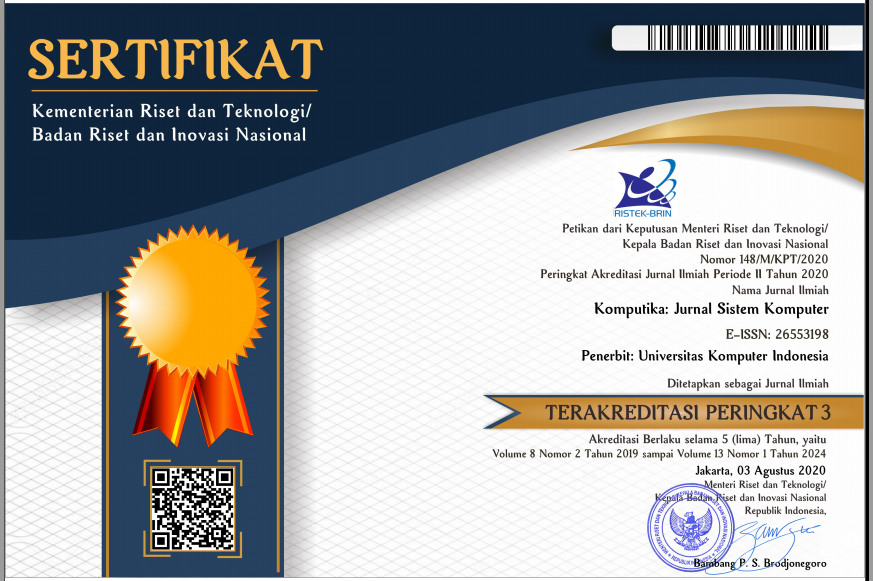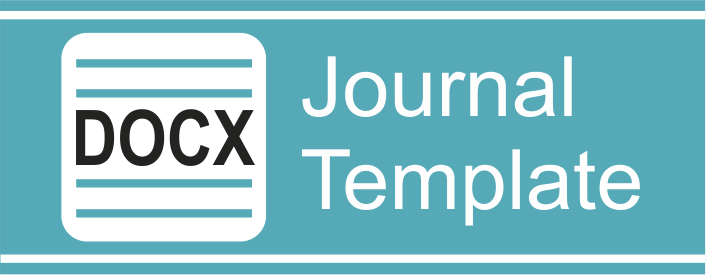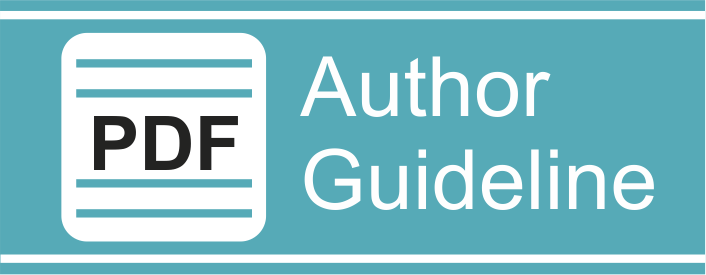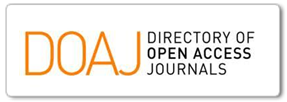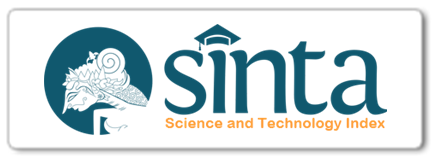Submissions
Author Guidelines
Author Guidelines and Journal Template already in this website. Please follow both.
-
Manuscripts can be written in Indonesian or English and typed in 2 columns (A4 paper size) with 10pt Book Antiqua font, with right-left aligned paragraph writing, and left, right, top, bottom margin settings of 2.5 cm each.
-
The manuscript begins with the title (max. 14 words), author's name (without title), institution and email address for correspondence.
-
The manuscript is accompanied by an abstract (100-200 words) written in Indonesian and English, each followed by 5 (five) keywords.
-
The abstract should explain what was researched/developed/thought about, the method and the results of the research so that the content of the manuscript can be illustrated without reading the entire paper.
-
The content of the manuscript contains/explains about:
Introduction: The introduction should contain (in order) a general background, a review of previous literature (state of the art) as a basis for stating the scientific novelty of the article, a gap analysis of what has been produced by previous research, and a statement of the importance of the research. At the end of the introduction, the purpose of the article should be explicitly stated. Writing a literature review is not allowed in the format of a scientific article, but can be written in the form of a review of previous literature to show the focus of these studies, the weaknesses of these studies, why this research is important and the objectives of the research that the author is conducting. Authors should avoid unnecessary duplication/repetition of their own/others' published work.
Methods and Materials: Methods describe the stages of research or development undertaken to achieve the aims/objectives of the research. Each stage is described briefly, e.g. each stage in one paragraph. Materials/materials/platforms used in the research are described in this section, which includes the subjects/materials studied, tools/auxiliary software used, experimental design or design used, sampling techniques, test plan (including: variables to be measured and data collection techniques), analysis and statistical models used.
Results and Discussion: This section contains the findings of the research/development and its scientific discussion. Scientific findings obtained from the results of the research that has been carried out are described in this section and supported by adequate data. The scientific findings referred to here are not the research data obtained (research data can be attached as supplementary files). The scientific findings must be explained scientifically and explained in relation to existing concepts and comparisons with previous studies, whether the research results are appropriate or not, better or not and other aspects.
Conclusion: this section contains to state the answer to the hypothesis and/or research objectives that have been stated in the introduction. The conclusion does not contain a reiteration of the results and discussion, but rather a summary of the findings as expected in the objectives or hypotheses. At the end of the conclusion, the author can also write things that will be done related to further ideas from the research.
Acknowledgments: Acknowledgments are addressed to the research funder or donor. Acknowledgments can also be made to parties other than the researchers listed as authors who helped carry out the research.
Bibliography: All references referred to in the text of the article must be listed in the Bibliography. The number of references used in the article should be at least 15. At least 80% of the references should be primary sources (scientific journals) published within the last 10 (ten) years. The citation format and bibliography must follow the IEEE format. Writing references in the article text and bibliography should use reference management application programs, such as Mendeley, EndNote and Zotero.
- Manuscript section titles and subtitles for different sections (introduction, methods and materials, results and discussion, and conclusions) are given Arabic numbers (1, 2, ..., etc.).
- The units of measure used and their abbreviations follow the rules of the International System of Units (SI).
- Equations are numbered sequentially with Arabic numbers in parentheses to the right of the equation (right-aligned).
- The use of symbols in equations is annotated in the manuscript section below.Insertion of figures and tables are accompanied by titles below (for figures) and above (for tables) and numbered consecutively.
- All figures and tables used must be referred to in the text.
Example for references:
[1] K. Chen, Linear Networks and Systems. Belmont, CA: Wadsworth, 1993, pp. 123-135.
[2] The Oxford Dictionary of Computing, 5th ed. Oxford: Oxford University Press, 2003.
[3] Bass, P. Clements, and R. Kazman, Software Architecture in Practice, 2nd ed. Reading, MA: Addison Wesley, 2003. [E-book] Available: Safari e-book.
[4] D. Lipson and B. D. Horwitz, “Photosensory reception and transduction,†in Sensory Receptors and Signal Transduction, J. L. Spudich and B. H. Satir, Eds. New York: Wiley-Liss, 2001, pp-1-64.
[5] B. R. Strimpel, "Computer graphics," in McGraw-Hill Encyclopedia of Science and Technology, 8th ed., Vol. 4. New York: McGraw-Hill, 1997, pp. 279-283.
[6] Altun, “Understanding hypertext in the context of reading on the web: Language learners’ experience,†Current Issues in Education, vol. 6, no. 12, July, 2005. [Online]. Available: http://cie.ed.asu.edu/volume6/number12/.[Access-ed Dec. 2, 2007].
[7] Ayasso and A. Mohammad-Djafari, "Joint NDT Image Restoration and Segmentation Using Gauss–Markov–Potts Prior Models and Variational Bayesian Computation," IEEE Transactions on Image Processing, vol. 19, no. 9, pp. 2265-77, 2010. [Online]. Available: IEEE Xplore, http://www.ieee.org. [Accessed Sept. 10, 2010].
[8] Chen, W. Huang, B. Zhou, C. Liu, W.H. Mow, "PiCode: a new picture-embedding 2D barcode", IEEE Transactions on Image Processing, vol. 25, no. 8, pp. 3444-3458, August 2016.
[9] Bánoci, M. Broda, G. Bugár, D. Levický, "Universal Image Steganalytic Method", In: Radioengineering, vol. 23, no. 4, pp. 1213-1220, December 2014, ISSN 1210-2512.
[10] Smith, R. Jones, and K. Trello, “Adaptive filtering in data communications with self improved error reference,†In Proc. IEEE International Conference on Wireless Communications ’04, 2004, pp. 65-68.
[11] Liu and H. Miao, "A specification based approach to testing polymorphic attributes," in Formal Methods and Software Engineering: Proc.of the 6th Int. Conf. on Formal Engineering Methods, ICFEM 2004, Seattle, WA, USA, November 8-12, 2004, J. Davies, W. Schulte, M. Barnett, Eds. Berlin: Springer, 2004. pp. 306-19.
[12] Lach, "SBFS: Steganography based file system," in Proc. of the 2008 1st Int. Conf. on Information Technology, IT 2008, 19-21 May 2008, Gdansk, Poland [Online]. Available: IEEE Xplore, http://www.ieee.org. [Accessed: 10 Sept. 2010].
[13] A. Nimr, "Defuzzification of the outputs of fuzzy controllers," presented at 5th Int. Conf. on Fuzzy Systems, 1996, Cairo, Egypt. 1996.
[14] Kimura and A. Lipeles, “Fuzzy controller component,†U. S. Patent 14, 860,040, 14 Dec., 2006.
[15] Texas Instruments, “High speed CMOS logic analog multiplexers/demultiplexers,†74HC4051 datasheet, Nov. 1997 [Revised Sept. 2002].
[16] European Telecommunications Standards Institute, “Digital Video Broadcasting (DVB): Implementati-on guidelines for DVB terrestrial services; transmission aspects,†European Telecommuni-cations Standards Institute, ETSI TR-101-190, 1997. [Online]. Available: http://www.etsi.org. [Accessed: Aug. 17, 1998].
[17] Sussman, "Home page - Dr. Gerald Sussman," July 2002. [Online]. Available: http:// www.comm.pdx.edu/faculty/Sussman/sussmanpage.htm. [Accessed: Sept. 12, 2004].
[18] Karnik, “Performance of TCP congestion control with rate feedback: TCP/ABR and rate adaptive TCP/IP,†M. Eng. thesis, Indian Institute of Science, Bangalore, India, Jan. 1999.
[19] Sudweeks, Development and Leadership in Computer-Mediated Collaborative Groups. PhD [Dissertation]. Murdoch, WA: Murdoch Univ., 2007. [Online]. Available: Australasian Digital Theses Program.
[20] Padhye, V. Firoiu, and D. Towsley, “A stochastic model of TCP Reno congestion avoidance and control,†Univ. of Massachusetts, Amherst, MA, CMPSCI Tech. Rep. 99-02, 1999.
[21] Wireless LAN Medium Access Control (MAC) and Physical Layer (PHY) Specification, IEEE Std. 802.11, 1997.
Source guidelines for references:
https://ieeeauthorcenter.ieee.org/wp-content/uploads/IEEE-Reference-Guide.pdf.
https://ieee-dataport.org/sites/default/files/analysis/27/IEEE%20Citation%20Guidelines.pdf.
Submission Preparation Checklist
All submissions must meet the following requirements.
- The submission has not been previously published, nor is it before another journal for consideration (or an explanation has been provided in Comments to the Editor).
- Where available, URLs for the references have been provided.
- The text adheres to the stylistic and bibliographic requirements outlined in the Author Guidelines.
- The submission file is in OpenOffice or Microsoft Word document file format.
- The text is single-spaced; uses a 10-point font; employs italics, rather than underlining (except with URL addresses); and all illustrations, figures, and tables are placed within the text at the appropriate points, rather than at the end.
Privacy Statement
The names and email addresses entered in this journal site will be used exclusively for the stated purposes of this journal and will not be made available for any other purpose or to any other party.

